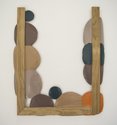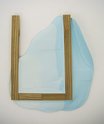John Hurrell – 24 May, 2017
These recent, innovative paintings are a brave move that in a sense shifts Snow's activity towards writing, or at least letters that start to cohere into words. As linear configurations they seem to emphasise the mechanics of cerebral processes, and the struggling articulations of thought as it is released from the 'inner' body - how its forms emerge out of chewed over mental fragments of whispering nonsense, resulting in tentative suggestions that eventually lead to the firming up of rudimentary ideas.
In this new exhibition of paintings by Glen Snow at Antoinette Godkin he takes a minimalist approach and a punning title, looking to a three edge frame to provide a reorganisable skeletal structure and foil for his blobs of mingled glue and acrylic. With vertical and horizontal vectors, and either butt or mitre joins at each baton end, the struts are straddled by solid curling puddles of paint. Although it might be argued this direction is part of the phenomenon described in Breaching The Frame, the book by Pedro Erber about contemporary art in Brazil and Japan, Snow is not so much ‘breaching’ as staying with the wall and using three wall-based vectors (that were previously perceived as ‘edges’) as devices for improvisation. Here the wooden batons are embedded in the paint and supported by it. Not the other way around.
Actually, that description is slightly simplified. The outer batons (closest to the viewer) are stuck in paint, but on the wall side of the thin paint ‘pikelets’ are other short bars of wood on which are attached metal triangles for hanging. Because the circles of paint have a slight sheen, the outlines of the hidden wooden strips (the horizontal rectangles) are detectable from the front - according to the angle of the light source in the room.
The other consequence of this is that soft shadows on the wall play a role, especially as the edges of the flat thin paint shapes sometimes curl away from the background white plane, or else remain parallel when projecting out. The configuration of vertical and horizontal batons - with their different sections of wavy woodgrain pattern that is sometimes abruptly changed, combined with the biscuitlike circular ‘flowers’ peeking out from behind - floats or hovers on the wall.
Usually Snow’s colour choices are such that the dominant paint blobs or squeezed splodges that maintain firm corners stay tonally related, so that the hues are all of a family - say brownish or dark green. Often tiny specks of brighter ‘foreign’ colour turn up isolated on the wooden struts as if splashed by accident, but gently enlivening the organic composition by virtue of surprise.
Being open and not enclosed (like a frame) in their visual structure means these images have a vaguely calligraphic mood, as if letters on the wall that are bleeding puddles: a requiem of coloured ‘blood’ for past conventions. H, Y, Z and U-shapes are all suggested by the strut formations, and some of the paint shapes look like giant suspended tongues hanging off a jungle gym, smaller versions (say) of works made by Helen Calder. The forms are airy, bubbly and often muddy as if pulled from the earth, while the silhouettes look like those of fruit hanging off a trellis. Sometimes counter rhythms are set up with clusters of much smaller discs (of ochre or grey) in front of the bigger ones.
Snow’s earlier works of course are denser and much more compact, and whilst I happen to prefer them, these recent, innovative paintings are a brave move that in a sense shifts his activity towards writing, or at least letters that start to cohere into words. To indulge my interpretative fantasy further, as linear configurations they seem to emphasise the mechanics of cerebral processes, and the struggling articulations of thought as it is released from the ‘inner’ body - how its forms emerge out of chewed over mental fragments of whispering nonsense, resulting in tentative suggestions that eventually lead to the firming up of rudimentary ideas.
John Hurrell











 Advertising in this column
Advertising in this column Two Rooms presents a program of residencies and projects
Two Rooms presents a program of residencies and projects



This Discussion has 0 comments.
Comment
Participate
Register to Participate.
Sign in
Sign in to an existing account.